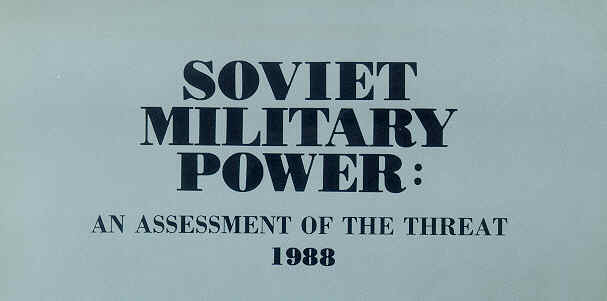CHAPTER IV - Soviet Strategic Programs and Space Forces - part 2
STRATEGIC DEFENSES
In a dramatic departure from past assertions that only the United States is working to "militarize" space, General Secretary Gorbachev acknowledged on 30 November 1987 that the USSR is involved in strategic defense research. He stated, "The Soviet Union is doing all that the United States is doing, and I guess we are engaged in research, basic research, which relates to these aspects which are covered by the SDI of the United States." But the Soviet effort into all aspects of strategic defense has been consistently far more vigorous than that of the United States.
Ballistic Missile Defense
The Soviets maintain the world's only operational ABM system, and a nearly completed construction program begun during the 1980s will yield an expanded and upgraded system comprising a two-layer defense of 100 launchers. When fully operational around 1989, the system will defend selected leadership and strategic facilities in the Moscow area.
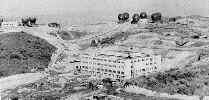 The
new Moscow ABM system includes two interceptor missiles: a long-range
modified GALOSH ABM that is intended to engage ballistic missile
reentry vehicles(RVs) outside the atmosphere; and the GAZELLE, a
shorter range, high-acceleration missile that, like the now-defunct US
SPRINT system, is designed to engage RVs after they have reentered the
Earth's atmosphere. New, hardened silos have been constructed for the
new interceptor missiles. The modified GALOSH and GAZELLE are expected
to become operational in 1988 or 1989.
The
new Moscow ABM system includes two interceptor missiles: a long-range
modified GALOSH ABM that is intended to engage ballistic missile
reentry vehicles(RVs) outside the atmosphere; and the GAZELLE, a
shorter range, high-acceleration missile that, like the now-defunct US
SPRINT system, is designed to engage RVs after they have reentered the
Earth's atmosphere. New, hardened silos have been constructed for the
new interceptor missiles. The modified GALOSH and GAZELLE are expected
to become operational in 1988 or 1989.
A large multifunction phased-array radar nearing completion at Pushkino is also an integral part of the new Moscow ABM system. The radar, which has 360-degree coverage, will provide support for the new interceptor systems. It is expected to reach full operational capability around 1989.
In the aggregate, the Soviet Union's ABM and ABM related actions suggest that the USSR may be preparing an ABM defense of its national territory. These actions include radar construction, concurrent testing, SAM upgrade, ABM rapid reload, ABM mobility, and deployment of ABM components to Gomel.
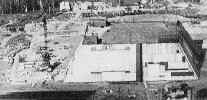 The
Soviets began building a large phased-array radar (LPAR) network in the
1970s, and since 1981 the number of LPARs under construction has more
than doubled. There are now nine LPARs in varying stages of completion,
forming a nearly complete ring of ballistic missile detection coverage
for the Soviet landmass. They duplicate and augment coverage provided
by the older HEN HOUSE ballistic missile early warning radars, but also
could provide the detailed detection and tracking data which would be
required for a nationwide ABM system. Since these radars take a long
time to construct, the entire network probably would not be operational
until the mid-199Os.
The
Soviets began building a large phased-array radar (LPAR) network in the
1970s, and since 1981 the number of LPARs under construction has more
than doubled. There are now nine LPARs in varying stages of completion,
forming a nearly complete ring of ballistic missile detection coverage
for the Soviet landmass. They duplicate and augment coverage provided
by the older HEN HOUSE ballistic missile early warning radars, but also
could provide the detailed detection and tracking data which would be
required for a nationwide ABM system. Since these radars take a long
time to construct, the entire network probably would not be operational
until the mid-199Os.
 The
Soviets have deployed and tested components required for an ABM system
that could be deployed to a site in months rather than years. Recent
Soviet activities with respect to moving a FLAT TWIN ABM radar and a
PAWN SHOP van, both components of an ABM system, from a test range and
initiating deployment at a location outside an ABM deployment area or
ABM test range, constitute a violation of the ABM Treaty. Moreover, the
SA-10/SAM system already in the air defense forces may have the
potential to intercept some types of ballistic missiles, as may the
SA-X-12B/GIANT when it is deployed.
The
Soviets have deployed and tested components required for an ABM system
that could be deployed to a site in months rather than years. Recent
Soviet activities with respect to moving a FLAT TWIN ABM radar and a
PAWN SHOP van, both components of an ABM system, from a test range and
initiating deployment at a location outside an ABM deployment area or
ABM test range, constitute a violation of the ABM Treaty. Moreover, the
SA-10/SAM system already in the air defense forces may have the
potential to intercept some types of ballistic missiles, as may the
SA-X-12B/GIANT when it is deployed.
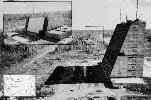 One
of the principal concerns regarding Soviet noncompliance with the ABM
Treaty is the Krasnoyarsk radar, which is in clear violation of the
treaty. The only permitted functions for an LPAR with Krasnoyarsk's
location and orientation would be space-tracking and National Technical
Means (NTM) of verification. Conclusive evidence suggests, however,
that this radar is primarily designed for ballistic missile detection
and tracking, not for space-tracking and NTM as the Soviets claim.
Moreover, the coverage of the Krasnoyarsk radar closes a major gap in
the coverage of the Soviet ballistic missile detection, warning, and
tracking screen. The location of the Krasnoyarsk radar allows it to
provide warning of a ballistic missile attack, to acquire attack
characterization data that will enable the Soviet strategic forces to
respond in a timely manner, and to aid in the battle management of
Soviet strategic defensive forces. All LPARs, including the Krasnoyarsk
radar, have the inherent capability to track large numbers of objects
accurately. Thus, they not only could perform as ballistic missile
detection, warning, and tracking radars, but also have an inherent
technical potential, depending on location and orientation, of
contributing to ABM battle management. A US Congressional delegation
visited the Krasnoyarsk LPAR facility on 5 September 1987 and was
allowed to view selected areas of both the transmitter and receiver
facilities. No information derived from this visit, however, changed
the assessment that the radar is designed for ballistic missile
detection and tracking.
One
of the principal concerns regarding Soviet noncompliance with the ABM
Treaty is the Krasnoyarsk radar, which is in clear violation of the
treaty. The only permitted functions for an LPAR with Krasnoyarsk's
location and orientation would be space-tracking and National Technical
Means (NTM) of verification. Conclusive evidence suggests, however,
that this radar is primarily designed for ballistic missile detection
and tracking, not for space-tracking and NTM as the Soviets claim.
Moreover, the coverage of the Krasnoyarsk radar closes a major gap in
the coverage of the Soviet ballistic missile detection, warning, and
tracking screen. The location of the Krasnoyarsk radar allows it to
provide warning of a ballistic missile attack, to acquire attack
characterization data that will enable the Soviet strategic forces to
respond in a timely manner, and to aid in the battle management of
Soviet strategic defensive forces. All LPARs, including the Krasnoyarsk
radar, have the inherent capability to track large numbers of objects
accurately. Thus, they not only could perform as ballistic missile
detection, warning, and tracking radars, but also have an inherent
technical potential, depending on location and orientation, of
contributing to ABM battle management. A US Congressional delegation
visited the Krasnoyarsk LPAR facility on 5 September 1987 and was
allowed to view selected areas of both the transmitter and receiver
facilities. No information derived from this visit, however, changed
the assessment that the radar is designed for ballistic missile
detection and tracking.
Advanced Strategic Defense Technologies
Since the 1960s, the Soviets have been conducting a substantial research program to develop a defense against ballistic missiles. As noted by General Secretary Gorbachev, this effort covers many of the same technologies currently being explored by the US SDI. The Soviet effort, however, involves a much greater investment of plant space, capital, and manpower.
For example, the Soviet laser research program, with ballistic missile defense applicability, has historically been much larger than its US counterpart. At Sary Shagan, one of a half-dozen major R&D facilities involved in laser research, the Soviets are believed to be developing several lasers for strategic applications such as air defense or a terminal ABM, and at least one laser believed capable of an antisatellite mission.
Moscow hopes that its huge investment to design and build high-energy lasers will provide it with laser systems for strategic air defense, space-based antisatellite missions and, conceivably, defense against ballistic missiles. The first prototype systems, some with limited operational capability, might be seen before the end of the decade, but except for air defense, full-scale, fully operational defensive systems are not expected until the late 1990s at the earliest.
In some areas of ballistic missile defense-related technology, the USSR has progressed beyond technology research. It has ground-based lasers with some capability to attack US satellites, and it could have a space-based antisatellite laser prototype within the next several years. The Soviets also could have ground-based laser prototypes for ballistic missile defense in the early 1990s, and they could begin testing a limited-scale deployment system in the late 1990s.
Moscow is exploring several other advanced technologies for use in ballistic missile defense. Since the late 1960s, for instance, the Soviets have explored the use of particle beam and kinetic energy weapons for antisatellite (ASAT) and ballistic missile defense missions. Although the Soviets may be able to test a prototype particle beam ASAT weapon in the mid-to-late 1990's, operational systems that could destroy satellites or incoming ballistic missiles will not exist until the 21st century.
Long-range, space-based kinetic energy weapons for defense against ballistic missiles probably could not be developed until at least the mid-199Os. The Soviets could, however, deploy a short-range, space-based system for space station defense or close-in attack by a maneuvering satellite in the near future.
The USSR has also conducted research in the use of radio-frequency weapons to interfere with or destroy the electronic components of ballistic missile warheads or satellites. A ground-based version of such a weapon could be tested in the 1990s. Free-electron lasers, which generate intense microwave and millimeter-wave pulses, have been developed by the Soviets, possibly for use in radio-frequency weapons.
Passive Defense
The Soviet passive defense program is a comprehensive system of
measures designed to inhibit the effects of a nuclear attack on the
Soviet Union. The main objectives of the passive defense program in
effect today are: ensuring the survival and continuity of the Soviet
leadership; planning for efficient wartime mobilization of manpower and
the economy; protecting the industrial base and essential workers; and
providing a credible reconstitution capability. Integral to the Soviet
passive defense program are thousands of hardened facilities.
Deep Underground Facilities
For 40 years, the Soviet Union has had a vast program underway to ensure the survival of the leadership in the event of nuclear war. This multifaceted program has involved the construction of deep underground bunkers, tunnels, secret subway lines, and other facilities beneath Moscow, other major Soviet cities, and the sites of major military commands. This program is designed solely to protect the senior Soviet leadership from the effects of nuclear war. These deep underground facilities today are, in some cases, hundreds of meters deep and can accommodate thousands of people. As nuclear arsenals on both sides have become larger and more potent, these facilities have been expanded and have reached greater depths.
Neither changes in the Soviets' leadership nor the restructuring of the strategic balance and the refinements in military doctrine that accompanied these changes appear to have diminished their commitment to the program. Over the program's history, its purpose has remained unchanged leadership survival so that it can maintain internal control and ensure that Soviet military power can be centrally directed throughout all phases of a world war. The secrecy of the program and the uncertainty about the extent and nature of these facilities are major causes for concern.
The deep underground program, which rivals Soviet offensive strategic weapons programs both in scale and level of commitment, remained undiminished even as the Soviets agreed to limit their defenses against ballistic missiles in the ABM Treaty. Indeed, a major augmentation of the original activities was started about the time the ABM Treaty was being concluded. Yet another round of construction on these complexes began in the early 1980s, when Soviet leaders were publicly emphasizing that a nuclear war would be so catastrophic that attempts to achieve victory or even seriously limit damage in such a war no longer made sense. The latest round of construction coincided with intensified Soviet preparations for the possibility that a nuclear war could be protracted.
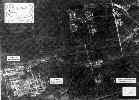 The
deep underground facilities beneath the city of Moscow are directly
associated with the main centers of state power. They provide the
leaders of the various organs of state control the opportunity to move
from their peacetime offices through concealed entry ways down to
protective quarters below the city, in some cases,hundreds of meters
down. Once there, the Politburo, the Central Committee, the Ministry of
Defense, the KGB, and the apparatuses of the many other state
ministries can remain sheltered while the USSR converts to a wartime
posture. The fruits of this 40-year construction program now offer the
Soviet wartime leadership the option of remaining beneath Moscow or, at
some point, boarding secret subway lines connecting these deep
underground facilities. From there the Soviets can make their way to
nearby underground complexes outside Moscow where they plan to survive
nuclear strikes and to direct the war effort. The support
infrastructure for these facilities is substantial. A highly redundant
communications system, consisting of both on-site and remote elements,
supports these complexes and permits the leadership to send orders and
receive reports through the wartime management structure.
The
deep underground facilities beneath the city of Moscow are directly
associated with the main centers of state power. They provide the
leaders of the various organs of state control the opportunity to move
from their peacetime offices through concealed entry ways down to
protective quarters below the city, in some cases,hundreds of meters
down. Once there, the Politburo, the Central Committee, the Ministry of
Defense, the KGB, and the apparatuses of the many other state
ministries can remain sheltered while the USSR converts to a wartime
posture. The fruits of this 40-year construction program now offer the
Soviet wartime leadership the option of remaining beneath Moscow or, at
some point, boarding secret subway lines connecting these deep
underground facilities. From there the Soviets can make their way to
nearby underground complexes outside Moscow where they plan to survive
nuclear strikes and to direct the war effort. The support
infrastructure for these facilities is substantial. A highly redundant
communications system, consisting of both on-site and remote elements,
supports these complexes and permits the leadership to send orders and
receive reports through the wartime management structure.
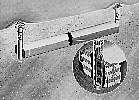 These
installations also have highly effective life support systems capable
of protecting their occupants against chemical and biological attack.
Such arrangements may enable independent operations to be carried out
from these facilities for many months. The top leadership of the USSR
also has the option of going by secret subway lines out to Vnukovo
Airfield, about 17 miles southwest of the Kremlin, and from there
flying to remote facilities. They also have a fleet of aircraft,
trains, and other vehicles that provide yet another option for
survival; these platforms have extensive communications support, which
would permit the surviving leadership to reconstitute Soviet military
power for ensuing military operations. While Soviet preparations for
leadership protection are most intensive around Moscow because of its
critical role in wartime management, there are similar programs in
other key cities. Moreover, Soviet planning calls for the leadership's
evacuation from several hundred additional cities to rural relocation
facilities.
These
installations also have highly effective life support systems capable
of protecting their occupants against chemical and biological attack.
Such arrangements may enable independent operations to be carried out
from these facilities for many months. The top leadership of the USSR
also has the option of going by secret subway lines out to Vnukovo
Airfield, about 17 miles southwest of the Kremlin, and from there
flying to remote facilities. They also have a fleet of aircraft,
trains, and other vehicles that provide yet another option for
survival; these platforms have extensive communications support, which
would permit the surviving leadership to reconstitute Soviet military
power for ensuing military operations. While Soviet preparations for
leadership protection are most intensive around Moscow because of its
critical role in wartime management, there are similar programs in
other key cities. Moreover, Soviet planning calls for the leadership's
evacuation from several hundred additional cities to rural relocation
facilities.
The Soviets also use worked-out mines to increase the number of relocation facilities. These old mines have the added advantage of reducing the cost of the passive defense program since the excavation costs have already been recovered. The mines would also provide concealed storage sites for military stores and equipment, expanded storage capacity for the strategic stocks reserve network, and improved continuity of economic activity in wartime. By using these old mines,the Soviets can expand the already large number of underground facilities available for leadership protection quickly and inexpensively.
The Soviets' experience with civil defense, leadership protection, and massive relocation efforts during World War II has taught them the benefits of a leadership protection program. While continuing improvements indicate the program does not yet fully meet Soviet requirements, the Soviets have made extensive preparations to give the leadership the potential for effective performance in a nuclear war. The enormous and continuing Soviet investments in the leadership protection program indicate that they believe its benefits are well worth the large cost. Unceasing efforts in strategic offensive forces and active defensive forces modernization, when coupled with efforts to protect the leadership, clearly indicate that the USSR expects to exercise national command and control through all phases of protracted nuclear war.
SPACE FORCES
The continuing evolution of Soviet military space doctrine, the increasing number of military-related launches, and the high priority given to development of space-related strategic offensive and defensive systems reflect the Soviet determination to use space primarily for military purposes. The long-term Soviet commitment to space was reaffirmed by General Secretary Gorbachev in May 1987 when he declared, "We do not intend to relax our efforts and lose our vanguard position in the conquest of space."
Space Programs and Capabilities
The Soviets currently operate about 50 types of space systems for military and civilian uses, including manned space stations (MIR and the inactive SALYUT 7), and reconnaissance, launch-detection, navigational, meteorological, and communications satellites. Some types of satellites - the Soviet space station, the materials processing satellite, the radar ocean reconnaissance satellite (RORSAT), the electronic intelligence(ELINT) ocean reconnaissance satellite (EORSAT), and the radar-carrying oceanographic satellite are unique to the Soviets.
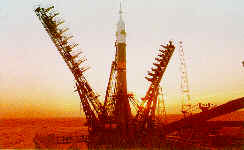 The
USSR conducts approximately 100 space launches annually from its three
"cosmodromes." One of these, Tyuratam, is the world's largest. To
maintain their impressive launch rate, the Soviets have about 20 launch
pads and use eight operational types of boosters to launch their
payloads. A ninth booster, the SL-X-17, is in development and testing.
Their high launch rate allows the Soviets to maintain an increasing
number of active satellites in orbit up from about 120 in 1982 to about
150 in 1987. At least 90 percent of the Soviet satellites in orbit have
military purpose and can support offensive or defensive operations.
The
USSR conducts approximately 100 space launches annually from its three
"cosmodromes." One of these, Tyuratam, is the world's largest. To
maintain their impressive launch rate, the Soviets have about 20 launch
pads and use eight operational types of boosters to launch their
payloads. A ninth booster, the SL-X-17, is in development and testing.
Their high launch rate allows the Soviets to maintain an increasing
number of active satellites in orbit up from about 120 in 1982 to about
150 in 1987. At least 90 percent of the Soviet satellites in orbit have
military purpose and can support offensive or defensive operations.
 Although
the Soviets steadfastly maintain they have no military space program,
about 150 of the approximately 200 operational Soviet satellites
projected to be in orbit by the mid-199Os will most likely have purely
military missions such as ocean reconnaissance and targeting,
electronic intelligence, imagery reconnaissance, and communications.
Another 40 will probably support joint military-civilian functions,
including communications, navigation, and weather data. The
approximately 10 remaining satellites are likely to conduct
interplanetary probes and other scientific missions. The lifetimes and
survivability of Soviet satellites are expected to increase during the
next 10 years because of more sophisticated technology and the
placement of satellites at higher altitudes.
Although
the Soviets steadfastly maintain they have no military space program,
about 150 of the approximately 200 operational Soviet satellites
projected to be in orbit by the mid-199Os will most likely have purely
military missions such as ocean reconnaissance and targeting,
electronic intelligence, imagery reconnaissance, and communications.
Another 40 will probably support joint military-civilian functions,
including communications, navigation, and weather data. The
approximately 10 remaining satellites are likely to conduct
interplanetary probes and other scientific missions. The lifetimes and
survivability of Soviet satellites are expected to increase during the
next 10 years because of more sophisticated technology and the
placement of satellites at higher altitudes.
Military Support From Space
The Soviets continue developing and deploying space systems designed to support military operations on Earth. They now have a fully operational network dedicated to warning them of an ICBM attack, and they operate several types of space-based reconnaissance systems. Two of these, the RORSAT and EORSAT, can be used to locate naval forces. Moreover, the Soviets practice their detection and targeting techniques, routinely launching these satellites to monitor both their own and NATO naval exercises.
 Moscow
continues to expand its sophisticated satellite reconnaissance program.
Several planned improvements such as a data-relay satellite system
could improve the timeliness of Soviet intelligence. Demonstrations of
flexibility and versatility in launching and deploying surveillance
systems have continued, and the Soviets are capable of redirecting them
for worldwide missions as required. Meanwhile, their satellite imagery
reconnaissance capability has been refined, and space-based electronic
intelligence is being upgraded.
Moscow
continues to expand its sophisticated satellite reconnaissance program.
Several planned improvements such as a data-relay satellite system
could improve the timeliness of Soviet intelligence. Demonstrations of
flexibility and versatility in launching and deploying surveillance
systems have continued, and the Soviets are capable of redirecting them
for worldwide missions as required. Meanwhile, their satellite imagery
reconnaissance capability has been refined, and space-based electronic
intelligence is being upgraded.
While the Soviets are expected to maintain their current launch-detection satellite network, they are probably working on a space-based surveillance system to detect the launch of US SLBMs, as well as European and Chinese missile launches. Although the USSR's land-based ballistic missile defense radar network permits detection of in flight SLBMs, a space-based geosynchronous launch-detection satellite system could increase warning time significantly. The Soviets will probably have the technical capability to deploy such a satellite system within the next several yearn
The Soviets continue deploying their space-based global navigation satellite system known as GLONASS. This system will probably provide highly accurate positioning data for military and civilian users by 1992. GLONASS is similar to the US NAVSTAR Global Positioning System (GPS). In fact, the Soviets used digital signal-processing data from GPS documents to develop GLONASS. GLONASS is being placed in a GPS-like orbit. Based on the 9 to 12 satellites announced for the system, GLONASS would have a worldwide, two-dimensional navigation capability. If the Soviets want GLONASS to provide worldwide, three-dimensional navigation upgrades, they would have to orbit 18 to 24 satellites.
The Soviets have continued developing and deploying radar-carrying satellite systems. Designed for mapping ice formations in polar regions, these satellites can greatly enhance the Soviet Navy's ability to operate in icebound areas by facilitating navigation of northern sea routes and assisting in such activities as routing naval ships from construction yards in the western USSR to new ports in the Pacific.
In July 1987, the Soviets orbited a very large, new type satellite using their PROTON booster rocket. According to the Soviets, COSMOS-1870 has an Earth-resources, remote-sensing mission, which reportedly includes experiments related to hydrology, cartography, geology, agriculture, and the environment. It uses an on board radar unit to gather data. Since no scientific data attributed to this spacecraft has even been discussed or publicly acknowledged to date, a strong military affiliation cannot be ruled out.
Manned Operations
 The
Soviet manned space program occupies a unique position in Moscow's
space efforts. It is heavily publicized to promote the perception of
the peaceful nature and technological superiority of the USSR's space
program. Nonetheless, the Soviets have made a strong commitment to
using their manned space program to accelerate their drive to achieve
military superiority in space. For the Soviets, having a man in space
provides unique observation, experimentation, execution,and command
functions which the US frequently uses remote systems to perform.
The
Soviet manned space program occupies a unique position in Moscow's
space efforts. It is heavily publicized to promote the perception of
the peaceful nature and technological superiority of the USSR's space
program. Nonetheless, the Soviets have made a strong commitment to
using their manned space program to accelerate their drive to achieve
military superiority in space. For the Soviets, having a man in space
provides unique observation, experimentation, execution,and command
functions which the US frequently uses remote systems to perform.
Soviet literature indicates that the military applications of remote sensing, oceanography, meteorology, and geodesy have been the focus of repeated cosmonaut investigations. Even civil investigations such as astronomical observations, also performed by cosmonauts, have military uses. The USSR may be using such investigations to develop techniques useful for maintaining the orientation of certain equipment to an accuracy of a few arc-seconds, a capability needed to aim directed energy weapons.
The ability to rendezvous and link up with uncooperative spacecraft, which Soviet cosmonauts demonstrated in 1985 and 1986, also has military applications. Cosmonauts use equipment such as a laser range finder, a night-vision device, and an optical sensor while performing this type of operation. The Soviets state that this rendezvous procedure will allow the rescue of cosmonauts stranded in orbit, but it could also be useful both for repairing friendly satellites and for inspecting and disabling enemy satellites.
A crucial cosmonaut activity is Earth observation, which has applications for reconnaissance and targeting. The Soviets report that their cosmonauts have used visual observations, cameras, spectrometers, and multispectral electro-optical sensors in their observations from the SALYUT and MIR space stations. These experiments suggest the Soviets are evaluating their ability to locate, identify, and track targets from outer space. Developing this ability could be the first step toward designing a space weapons platform for use against targets in space and on Earth. Such a platform may eventually be used for ASAT and ballistic missile defense operations, as well as for space station defense.
In 1986, the USSR launched a new-generation space station MIR to replace the aging SALYUT-7. MIR is an impressive advancement over SALYUT-7, having enhanced solar energy and electrical power systems, greater computer capabilities, and individual"cabins" for crew members. Most significantly, while SALYUT-7 had only two docking ports, MIR has six.
With the launch of MIR, a space station module, and regular crew rotations with the SOYUZ-TM capsule, the Soviets have probably begun their permanent manned presence in space. The crew launched in February had a partial crew change in July 1987, and the remaining cosmonaut, Colonel Yuri Romanenko, was relieved in December 1987 after setting two space endurance records. In the early-to-mid 1990s, the Soviets should be able to construct a very large modular space station. They have discussed housing up to 100 cosmonauts in such a space complex.
Antisatellite Operations
In addition to space programs which could be construed as having both military and civilian applications, the Soviets have space systems that are purely military in nature. Indicative of the Soviet military program for space is their development and maintenance of the world's only currently operational ASAT system, a ground-based orbital interceptor. Using a radar sensor and a pellet-type warhead, the interceptor can attack all current low-altitude satellites. A target engagement during the first orbit of the intercept leaves little time for a target satellite to take evasive action. The interceptor can reach targets orbiting at an altitude of more than 5,000 kilometers, but it is probably intended for high-priority satellites at lower altitudes.
The ASAT interceptor is launched from Tyuratamon on SL-11 launch vehicles. Two launch pads, storage space for many interceptors, and the launch vehicles are available at the Tyuratam facility. Several interceptors could be launched each day from each of the pads.
Given the complexity of launch, target tracking, and radar-guided intercept, the Soviet ASAT system is far from primitive. Soviet ASAT tests have been largely successful, providing them with an operational system fully capable of performing its mission. Although the Soviets have not launched their ASAT system in several years, in an effort to forestall US development of an ASAT weapon, they have maintained their ASAT readiness. Over the past several years,the Soviets have routinely launched the SL-11 ASAT booster with other payloads, thereby ensuring the reliability of this system component. Other components can be tested on the ground without actually having to launch the ASAT system itself. The nuclear-armed GALOSH ABM also has an inherent ASAT capability against low-altitude satellites. The Soviet Union also has ground-based lasers with some capability to irradiate US satellites.
New Space Launch Systems
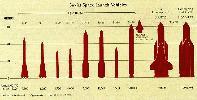 The
Soviet space program's success is due largely to its versatile and
reliable inventory of space launch vehicles (SLVs) and its space launch
and support facilities. The Soviets send a satellite aloft every three
or four days, using one of eight types of operational SLVs. The USSR's
impressive ability to launch various spacecraft quickly gives the
Soviets a distinct operational military advantage in any crisis. Most
malfunctioning satellites could be rapidly replaced, and additional
satellites could be launched to cover new or expanding areas in a
crisis. In fact, if all deployed Soviet satellites were destroyed, the
Soviets have sufficient standby lift capability to replace them within
two to three months, provided reserve satellites were available.
The
Soviet space program's success is due largely to its versatile and
reliable inventory of space launch vehicles (SLVs) and its space launch
and support facilities. The Soviets send a satellite aloft every three
or four days, using one of eight types of operational SLVs. The USSR's
impressive ability to launch various spacecraft quickly gives the
Soviets a distinct operational military advantage in any crisis. Most
malfunctioning satellites could be rapidly replaced, and additional
satellites could be launched to cover new or expanding areas in a
crisis. In fact, if all deployed Soviet satellites were destroyed, the
Soviets have sufficient standby lift capability to replace them within
two to three months, provided reserve satellites were available.
 Even
with their current launch capability, the Sovietsare expanding their
extensive family of SLVs with new expendable launch vehicles and
reusable manned spacecraft. The deployment of the medium-lift Titan
IIIC-Class SL-16 and the heavy-lift Saturn V-Class SL-X-17 will
increase the payload weight of satellites the Soviets will be able to
orbit.
Even
with their current launch capability, the Sovietsare expanding their
extensive family of SLVs with new expendable launch vehicles and
reusable manned spacecraft. The deployment of the medium-lift Titan
IIIC-Class SL-16 and the heavy-lift Saturn V-Class SL-X-17 will
increase the payload weight of satellites the Soviets will be able to
orbit.
On 15 May 1987, the Soviets conducted the first flight test of the SL-X-17, which they designated "Energiya"(Energy). They openly announced that "military experts took part in creating and testing" the new launch vehicle. The Soviets reported that "Energiya's" first stage (the strap-on boosters) and the second stage (the core vehicle) operated as planned. They also stated that an attempt was made to orbit a satellite during this test. The satellite mockup engines apparently did not function properly and the satellite splashed down in the Pacific Ocean. The failure of the payload, however, was not due to problems with the booster, which performed as intended.
 The
SL-X-17 heavy-lift vehicle will be used to launch the Soviet space
shuttle orbiter as one of its payloads. Launch-pad compatibility
testing of an orbiter attached to the SL-X-17 vehicle may already have
taken place, and it appears that a test flight will occur soon. By
using US propulsion, computer, materials, and airframe
technology and designs, the Soviets were able to produce an orbiter
years earlier, and at far less cost, than if they had depended solely
on their own technology and engineering.
The
SL-X-17 heavy-lift vehicle will be used to launch the Soviet space
shuttle orbiter as one of its payloads. Launch-pad compatibility
testing of an orbiter attached to the SL-X-17 vehicle may already have
taken place, and it appears that a test flight will occur soon. By
using US propulsion, computer, materials, and airframe
technology and designs, the Soviets were able to produce an orbiter
years earlier, and at far less cost, than if they had depended solely
on their own technology and engineering.
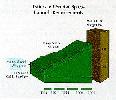 Development
of a heavy-lift launch system with its main engines on the core vehicle
rather than the orbiter gives the system the versatility to launch
either an orbiter or other very heavy payloads. The SL-X17, for
example, will be able to place payloads of over 100,000 kilograms into
low-Earth orbit, a figure comparable to that carried by the
discontinued US Saturn V rocket. Potential payloads for the SL-X-17
include modules for a large space station, components for manned and
unmanned interplanetary missions, and perhaps directed-energy ASAT and
ballistic missile defense weapons and other space-based components of
the Soviet strategic defense program.
Development
of a heavy-lift launch system with its main engines on the core vehicle
rather than the orbiter gives the system the versatility to launch
either an orbiter or other very heavy payloads. The SL-X17, for
example, will be able to place payloads of over 100,000 kilograms into
low-Earth orbit, a figure comparable to that carried by the
discontinued US Saturn V rocket. Potential payloads for the SL-X-17
include modules for a large space station, components for manned and
unmanned interplanetary missions, and perhaps directed-energy ASAT and
ballistic missile defense weapons and other space-based components of
the Soviet strategic defense program.
 The
SL-16 booster is capable of placing a payload of more than 15,000
kilograms into low-Earth orbit. This capability filled a gap in the
Soviet SLV inventory by providing an economical means of launching
medium weight payloads. One candidate payload for the SL-16 could be a
space plane, a subscale version of which has been flight-tested in
orbit; a full-scale test version is possibly in production. A small,
manned spacecraft could be used for quick-reaction, real-time
reconnaissance missions, satellite repairs and maintenance, crew
transport, space station defense, satellite inspection and, if
necessary, satellite destruction.
The
SL-16 booster is capable of placing a payload of more than 15,000
kilograms into low-Earth orbit. This capability filled a gap in the
Soviet SLV inventory by providing an economical means of launching
medium weight payloads. One candidate payload for the SL-16 could be a
space plane, a subscale version of which has been flight-tested in
orbit; a full-scale test version is possibly in production. A small,
manned spacecraft could be used for quick-reaction, real-time
reconnaissance missions, satellite repairs and maintenance, crew
transport, space station defense, satellite inspection and, if
necessary, satellite destruction.
The introduction of the SL-16 and SL-X-17, coupled with an expected greater use of the SL-12 and SL-13SLVs, will increase substantially the payloads the Soviets will be capable of launching into space. In fact, during the next five years, the Soviets are expected to double the annual payload weight launched into orbit, and quadruple that weight within 15 years.
PROSPECTS
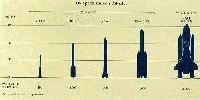 While
the INF Treaty marks an important step in reducing the threat of
nuclear war, the residual
Soviet nuclear arsenal will still contain some 1,400 ICBMs, nearly
1,000 SLBMs, and a large number of cruise missiles, short-range
ballistic missiles, and tactical missile and artillery systems.
While
the INF Treaty marks an important step in reducing the threat of
nuclear war, the residual
Soviet nuclear arsenal will still contain some 1,400 ICBMs, nearly
1,000 SLBMs, and a large number of cruise missiles, short-range
ballistic missiles, and tactical missile and artillery systems.
Even if a strategic arms reduction treaty is concluded and ratified, the Soviets can be expected to continue to improve their strategic nuclear weapons, especially for accuracy, mobility, and survivability. Their short-range ballistic missile force, which is expected to grow steadily, will remain a potentially devastating strike force. Continued Soviet development of a new class of cruise missiles with greater accuracy than currently deployed ballistic missiles will enhance the deep-strike capability of theater bombers and increase bomber survivability by providing a standoff capability. Furthermore, the Soviets show no sign of abandoning any aspect of their strategic defense program, despite its approximate $20 billion per year cost.


